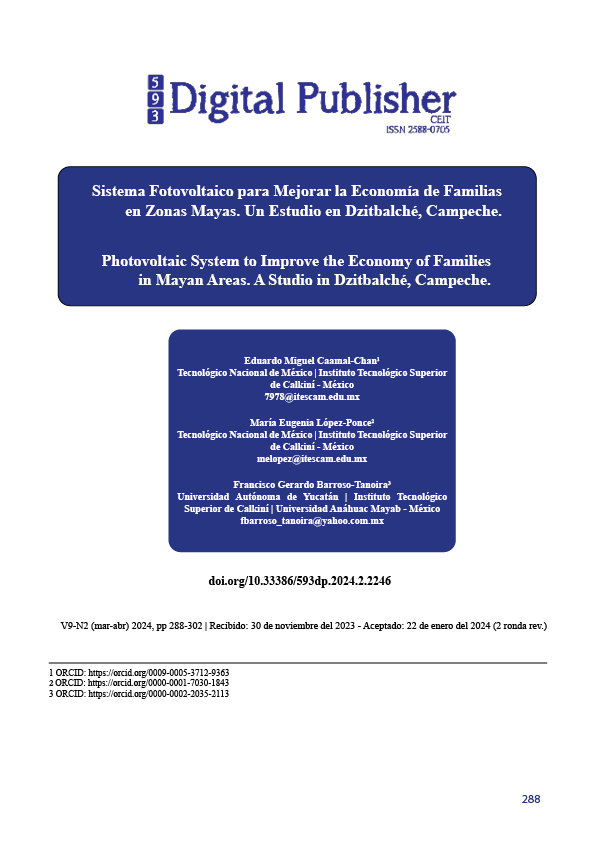Photovoltaic System to Improve the Economy of Families in Mayan Areas. A Studio in Dzitbalché, Campeche.
Main Article Content
Abstract
The present study addresses the effectiveness of the implementation of a photovoltaic system for interconnection to the electrical grid of the Federal Electricity Commission (CFE), in single-family homes in the municipality of Dzitbalché, on Camino Real de Campeche, to reduce the costs of energy and improve their quality of life in a sustainable way. An analysis was carried out to determine the best photovoltaic systems according to income, the characteristics of the single-family homes and the environmental environment of the municipality under study, as well as the sustainability of the energy produced in the homes.
The research consists of two parts: (1) interviews with inhabitants of single-family homes, and (2) recording of radiation and kilowatts generated by the photovoltaic system. In both, the scope was exploratory and then descriptive, with a non-experimental cross-sectional design. In the first, the approach was qualitative and the method was inductive, with the interview as a technique and its corresponding question guide. For the second, the approach was quantitative and the method was deductive, based on directed observation through a verification sheet as a collection instrument. Due to the geographical location and the radiation index that predominates in the area, the results are very favorable for the generation of electricity, which considerably reduces the cost of electricity bills. The conclusions show that the implementation of the system is not only effective, but also efficient in its operation. Habits for saving electrical energy in homes are also proposed.
Downloads
Article Details

This work is licensed under a Creative Commons Attribution-NonCommercial-ShareAlike 4.0 International License.
1. Derechos de autor
Las obras que se publican en 593 Digital Publisher CEIT están sujetas a los siguientes términos:
1.1. 593 Digital Publisher CEIT, conserva los derechos patrimoniales (copyright) de las obras publicadas, favorece y permite la reutilización de las mismas bajo la licencia Licencia Creative Commons 4.0 de Reconocimiento-NoComercial-CompartirIgual 4.0, por lo cual se pueden copiar, usar, difundir, transmitir y exponer públicamente, siempre que:
1.1.a. Se cite la autoría y fuente original de su publicación (revista, editorial, URL).
1.1.b. No se usen para fines comerciales u onerosos.
1.1.c. Se mencione la existencia y especificaciones de esta licencia de uso.
References
Acciona (2020). Energía Solar. https://www.acciona.com/es/energias-renovables/energia-solar/?_adin=02021864894
Aguado-Puig, A. (2018). Desarrollo sostenible: 30 años de evolución desde el informe Brundtland. (Tesis doctoral inédita). Universidad de Sevilla, Sevilla. https://idus.us.es/handle/11441/81489
AlusínSolar (2020) Principales componentes de una instalación fotovoltaica. https://alusinsolar.com/principales-componentes-de-una-instalacion-fotovoltaica/
André, F. J., De Castro, L. M., & Cerdá, E. (2012). Las energías renovables en el ámbito internacional. Cuadernos económicos de ICE, 83, 11-36. https://www.researchgate.net/profile/Francisco-Andre/publication/277269010_Las_energias_renovables_en_el_ambito_internacional/links/5582861308ae12bde6e4c5bf/Las-energias-renovables-en-el-ambito-internacional.pdf
Arencibia-Carballo, G. (2016). La importancia del uso de paneles solares en la generación de energía eléctrica. REDVET. Revista Electrónica de Veterinaria, 17(9),1-4.[fecha de Consulta 28 de Octubre de 2022]. https://www.redalyc.org/articulo.oa?id=63647456002
Arévalo, W. (2021). Optimización en dimensionamiento y control energético de sistemas híbridos de energías renovables en Ecuador. Universidad de Jaén. https://ruja.ujaen.es/handle/10953/1056
Bachiller-Araque, J. (2010). Energía y Sostenibilidad. El reto europeo del logro de los objetivos del 2020. Economía industrial, (377), 127-139. https://www.mincotur.gob.es/Publicaciones/Publicacionesperiodicas/EconomiaIndustrial/RevistaEconomiaIndustrial/377/127.pdf
Barbosa-García, O., Maldonado, J. L., Ramos-Ortiz, G., Rodríguez, M., Pérez-Gutiérrez, E., Meneses-Nava, M. A., ... & de Alba, P. L. L. (2012). Celdas solares orgánicas como fuente de energía sustentable. Acta Universitaria Multidisciplinary Scientific Journal, 22(5), 36-48. https://www.redalyc.org/pdf/416/41623360005.pdf
Beguiristáin-Repáraz, I. (2000). La vivienda unifamiliar y la búsqueda del ideal orgánico: una experiencia truncada. https://dadun.unav.edu/bitstream/10171/23519/1/2000%2019.pdf
Beltrán-Telles, A., Morera-Hernández, M., López-Monteagudo, F. E., & Villela-Varela, R. (2017). Prospectiva de las energías eólica y solar fotovoltaica en la producción de energía eléctrica. CienciaUAT, 11(2), 105-117. https://www.scielo.org.mx/scielo.php?pid=S2007-78582017000100105&script=sci_arttext
Camones-Olaza, M. A. (2019). Evaluación de patologías del concreto de las viviendas unifamiliares del puerto de Huarmey, Ancash. http://repositorio.unjfsc.edu.pe/handle/20.500.14067/2940
Damia Solar (2022). Tipos de paneles solares fotovoltaicos. https://www.damiasolar.com/actualidad/blog/articulos-sobre-la-energia-solar-y-sus-componentes/tipos-de-placas-solares-fotovoltaicas_1
Efimarket (2023). ¿Qué es la Hora Solar Pico (HSP), para qué sirve y cómo calcularlo?. https://www.efimarket.com/blog/la-hora-solar-pico-hsp-sirve-calcularlo/#:~:text=De%20forma%20sencilla%20decimos%20que,que%20est%C3%A1%20trasmitiendo%201000W%2Fm2.
Guerra, N., Guevara, M., Palacios, C., & Crupi, F. (2018). Operation and physics of photovoltaic solar cells: an overview. Revista de I+D Tecnológico, 14(2), 84-95. https://core.ac.uk/download/pdf/234019594.pdf
Hernández-Sampieri, R., & Mendoza, C. (2018). Metodología de la investigación: la ruta cuantitativa, cualitativa y mixta. Mc Graw Hill Education.
Hilario-Antonio, M. P. (2021). Análisis de sistema de energía eléctrica utilizando celdas fotovoltaicas en las zonas rurales de la región Junín. https://repositorio.uncp.edu.pe/bitstream/handle/20.500.12894/6849/T010_76240395_T.pdf?sequence=1
Huerta-Mascotte, E., Mata-Chávez, R. I., Estudillo-Ayala, J. M., Sierra-Hernández, J. M., Guryev, I., & Lizarraga-Morales, R. A. (2016). Estudio de las características de una celda fotovoltaica para el uso eficiente de la energía solar. Acta Universitaria Multidisciplinary Scientific Journal, 26. https://www.actauniversitaria.ugto.mx/index.php/acta/article/view/868
Lamigueiro, O. P. (2013). Energía solar fotovoltaica. Creative Commons ebook. España. 192pp.https://www.researchgate.net/profile/Oscar-Perpinan-Lamigueiro/publication/249012821_Energia_Solar_Fotovoltaica/links/02e7e51e80783f1d9f000000/Energia-Solar-Fotovoltaica.pdf
Mireles-Sosa, C. T. (2017). Análisis financiero de inversión en planta fotovoltaica en las Islas Canarias para periodo del 2008 al 2014 (Tesis de licenciatura inédita). https://accedacris.ulpgc.es/bitstream/10553/42052/2/TFG_Mireles%20Sosa%20Cristina%20Tatiana(1).pdf
Naal-Ocampo, A., Martín-Canché, B. R., Vanoye-Eligio, M., Casado-Ramírez, E. J., Guillén-Taje, J. L., & Alavez-Góngora, J. A. (2022). Cultura de ahorro energético en hogares del municipio de Escárcega, Campeche. Ciencia Latina Revista Científica Multidisciplinar, 6(6), 5975-5684. https://ciencialatina.org/index.php/cienciala/article/view/3835
Naciones Unidas (s.f.). Objetivos de Desarrollo Sostenible. https://www.un.org/sustainabledevelopment/es/objetivos-de-desarrollo-sostenible/
Pasquevich, D. M. (2016). Los beneficios del uso racional y eficiente de la energía. https://core.ac.uk/download/pdf/224793128.pdf#page=27
Robledo-Leal, G. M. (2008, 22 al 24 de octubre). Calidad de la energía eléctrica: camino a la normalización. Simposio de Metrología, https://www.cenam.mx/simposio2008/sm_2008/memorias/S5/SM2008-S5B2-1188.pdf
Roldán-Viloria, J. (2008). Fuentes de energía. Ediciones Paraninfo, SA. https://books.google.es/books?hl=es&lr=&id=1VSdl7o_t2kC&oi=fnd&pg=PP1&dq=fuentes+de+energ%C3%ADa&ots=aGrctYXEg4&sig=nz9dr0mdPx_tF4CFh32Y9aiQDEo#v=onepage&q=fuentes%20de%20energ%C3%ADa&f=false
Shallenberg, J., Rodríguez, G., Piernavieja-Izquierdo, C, Hernández-Rodríguez, P., Unamunzaga-Falcón, R., García-Déniz, M., Díaz-Torres, D., Cabrera-Pérez, G., Martel-Rodríguez, J., Pardilla-Fariña, V., & Ortin, S. (2008). Energías renovables y eficiencia energética. Instituto Tecnológico de Canarias, S.A. https://www.cienciacanaria.es/files/Libro-de-energias-renovables-y-eficiencia-energetica.pdf
Secretaría de Energía (2016). Prospectiva de energías renovables 2016-2030. https://www.gob.mx/cms/uploads/attachment/file/177622/Prospectiva_de_Energ_as_Renovables_2016-2030.pdf
Solarama (2023). ¿Qué es y cómo calcular hora solar pico? https://solarama.mx/blog/como-calcular-hora-solar-pico/
Valdés-Barrón, M. G., Bonifaz-Alfonzo, R., González-Cabrera, A. E., Estévez-Pérez, H. R., Rodríguez-Rasilla, I., Retama-Hernández, A., & Riveros-Rosas, D. (2020). Energía solar disponible en la ciudad de México. En CIES2020-XVII Congresso Ibérico e XIII Congresso Ibero-americano de Energía Solar (pp. 905-910). LNEG-Laboratorio Nacional de Energía y Geología. https://repositorio.lneg.pt/handle/10400.9/3445




